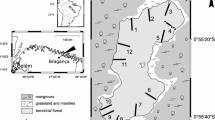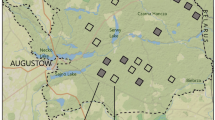Abstract
Spatial patterns are important characteristics of the forest and theycan reveal such things as successional status and ecological characteristics ofthe species. We tested the hypothesis that spatial distribution will bedifferent, depending on whether the species is intolerant or tolerant to shade.We assessed the spatial distribution of trees (> 4 cm dbh) andjuveniles in eight laurel forest plots. A univariate spatial analysis(performed with Ripley's K1) showed that all tree species havesignificantaggregation at short distances (2 m). Nevertheless, two groups ofspecies could be differentiated: Erica scoparia,Myrica faya and Ilex canariensisshowed a tendency for aggregation at large distances (larger than 6m)while L. azorica and Prunuslusitanicashowed aggregation only at shorter distances. Ripley's BivariateK1,2 analyses showed no significant differences in the spatialdistribution ofanalyzed species pairs from a null model. Only Laurusazoricahad a sufficient sample size for analysis of juvenile distribution. Aunivariateanalysis revealed thatL. azorica seedlings (stems < 50 cm high)were clumped in some plots up to 5 m, but this was not consistent.Saplings (stems > 50 cm high and < 4 cm dbh)didnot show strong clumping even at short distances. L.azoricasaplings had no significant aggregation with, nor repulsionfrom, adults of the same or different species. Spatial patterns of the speciesshould be considered in the development of restoration plans of the laurelforest 90%of which has disappeared or been intensively disturbed on Tenerife Island.
Similar content being viewed by others
References
Akashi N. 1996. The spatial pattern and canopy-understory association of trees in a cool temperate, mixed forest in western Japan. Ecological Research 11: 311–319.
Alekseev A.S. and Zherebtsov R.R. 1995. Regularities of spatial distribution of damaged vegetation under conditions of regional and local air pollution (with reference to the impact zone around the Pechenganikel mining and smelting plant). Russian Journal of Ecology 26: 428–435.
Ancochea E., Fuster J.M., Ibarrola E., Cendrero A., Coello J., Hernán F. et al. 1990. Volcanic evolution of the island of Tenerife (Canary Islands) in the light of new K-AR data. J. Volc. Geotherm. Res. 4: 231–249.
Arévalo J.R. 1998. Organización espacial y temporal de la laurisilva de Anaga-Tenerife. Islas Canarias. PhD Dissertation.
Arévalo J.R. and Fernández-Palacios J.M. 1998. Treefall gap characteristics and its influence on regeneration in the laurel forest of Tenerife. Journal of Vegetation Science 9: 297–306.
Arévalo J.R. and Fernández-Palacios J.M. 2000. Seed bank analysis of tree species in two stands of the Tenerife laurel forest (Canary Islands). Forest Ecology and Management 130: 177–185.
Augspurger C.K. 1983. Offspring recruitment around tropical trees: changes in cohort distance with time. Oikos 40: 189–196.
Bailey T.C. and Gatrell A.C. 1995. Interactive spatial data analysis. Longman Scientific and Technical, Essex.
Busing R.T. 1996. Estimation of tree replacement in an Appalachian Picea-Abies forest. Journal of Vegetation Science 7: 685–694.
Busing R.T. 1998. Composition, structure and diversity of cover forest stands in the Great Smoky Mountains: a patch dynamic perspective. Journal Vegetation Science 9: 881–890.
Ceballos L. and Ortuño F. 1974. Vegetatión y flora forestal de las Canarias Occidentales. 2nd edn. Cabildo Insular de Tenerife, Santa Cruz de Tenerife.
Chapin F.S., McGraw J.B. and Shaver G.C. 1989. Competition causes regular spacing of alder in Alaskan shrub tundra. Oecologia 79: 412–416.
Clark D.A. and Clark D.B. 1984. Spacing dynamics of a tropical rain forest tree: evaluation of the Janzen-Connell model. American Naturalist 117: 923–943.
Collins S.L. and Klahr S.C. 1991. Tree dispersion in oak-dominated forest along an environmental gradient. Oecologia 86: 471–477.
Condit. R., Hubbell S.P. and Foster R.B. 1992. Recruitment near conspecific adults and the maintenance of tree and shrub diversity in a neotropical forest. American Naturalist 140: 261–286.
Delgado J.D. 2000. Selection and treatment of fleshy fruits by the ship rata (Rattus rattus L.) in the Canarian laurel forest. Mammalia 64: 11–18.
Duncan R.D. 1991. Competition and the coexistence of species in a mixed podocarp stand. Journal of Ecology 79: 1073–1084.
Fernández-Caldas E., Tejedor M. and Quantin P. 1985. Los suelos volcánicos de Canarias. Servicio de Publicaciones, Universidad de La Laguna, La Laguna.
Fernández-Palacios J.M. and Arévalo J.R. 1988. Regeneration strategies of tree species in the laurel forest of Tenerife (The Canary Islands). Plant Ecology 137: 21–29.
Good B.J. and Whipple S.A. 1982. Tree spatial patterns: South Carolina bottomland swamp forest. Bulletin of the Torrey Botanical Club 109: 529–536.
Greig-Smith P. 1952. Ecological observations on degraded and secondary forest in Trinidad, British West Indies: EL Structure of the communities. Journal of Ecology 40: 316–330.
Hamill D.N. and Wright S.J. 1986. Testing the dispersion of juveniles relative to adults: a new analytic method Ecology. Ecology 67: 952–957.
Hansen A. and Sunding P. 1985. Flora of Macaronesia. Checklist of vascular plants, 3rd ed. Sommerfeldtia 1: 1–67.
Hatton T.J. 1989. Spatial patterning of sweet briar (Rosa rubignosa) by vertebrate species. Australian Journal of Ecology 14: 199–205.
He F., Legendre P. and LaFrankie J.V. 1997. Distribution patterns of tree species in a Malaysian tropical rain forest. Journal of Vegetation Science 8: 105–114.
Horn H.S. 1975. Markovian processes of forest succession. In: Cody M.L. and Diamond J.M. (eds), Ecology and Evolution of communities. Belknap Press, Cambrefidge, Massachusetts, USA, pp. 196–211.
Kämmer F. 1974. Klima und vegetation auf Tenerife, besonders in Hinblick auf den Nebelniederschlag. Scripta Geobot. 7: 1–78.
Lepš J. 1990. Can underlying mechanisms be deduced from observed patterns? In: Krahulec F., Agnew A.D.Q., Agnew S. and Willems J.H. (eds), Spatial Processes in Plant Communities. SPB Academic Publ., The Hague, pp. 1–11.
Lepš J. and Kindlman P. 1987. Models of the development of spatial pattern of an even-aged plant population over time. Ecol. Model 39: 45–57.
Manabe T. and Yamamoto S.I. 1997. Spatial distribution of Eurya japonica in an old-growth evergreen broad-leaved forest, SW Japan. Journal of Vegetation Science 8: 761–772.
Moeur M. 1993. Characterizing spatial patterns of trees using stemmapped data. Forest Science 39: 756–775.
Norton D.A. 1991. Seedling and sapling distribution patterns in a coastal podocarp forest, Hokitika Ecological District, New Zealand. New Zealand Journal of Botany 29: 563–466.
Oliver C.D. and Larson B.C. 1990. Forest Stand Dynamics. McGraw-Hill, New York.
Parsons J.J. 1981. Human influence in the pine and laurel forest of the Canary Islands. Geographical Review 71: 253–271.
Ripley B.D. 1977. Modelling spatial patterns. J.R. Stat. Soc. B. 39: 172–212.
Salonen V., Pettinen A. and Särkkä A. 1992. Plant colonization on bare peat surface: population changes and spatial patterns. Journal Vegetation Science 3: 113–118.
Swaine M.D. and Whitmore T.C. 1988. On the definition of ecological species groups in tropical rain forests. Vegetation 75: 81–86.
Szwagrzk J. 1990. Regeneration of forest related to the spatial structure of trees: A study of two forest communities in Western Carpathians, southern Poland. Vegetation 89: 11–22.
Szwagrzk J. 1992. Small scale spatial patterns of trees in a mixed Pinus sylvestris-Fagus sylvatica forest. Forest Ecology and Management 51: 469–476.
Szwagrzyk J. and Czerwczak M. 1993. Spatial patterns of trees in natural forest of East-Central Europe. Journal of Vegetation Science 4: 469–479.
Vacek S. and Lepš J. 1996. Spatial dynamics of forest decline: the role of neighboring trees. Journal of Vegetation Science 7: 789–798.
van der Maarel E. 1993. Plant species turnover and minimum area in a limestone grassland. Abstracta Botanica 17: 173–178.
Whitmore T.C. 1989. Canopy gaps and the two major group of forest trees. Ecology 70: 536–538.
Whipple S.A. 1980. Population dispersion patterns of trees in a southern Louisiana hardwood forest. Bulletin of the Torrey Botanical Club 107: 71–76.
Woods K.D. 1979. Reciprocal replacement and the maintenance of codominance in a beech-maple forest. Oikos 33: 31–39.
Author information
Authors and Affiliations
Corresponding author
Rights and permissions
About this article
Cite this article
Arévalo, J.R., Fernández-Palacios, J.M. Spatial patterns of trees and juveniles in a laurel forest of Tenerife, Canary Islands. Plant Ecology 165, 1–10 (2003). https://doi.org/10.1023/A:1021490715660
Issue Date:
DOI: https://doi.org/10.1023/A:1021490715660




